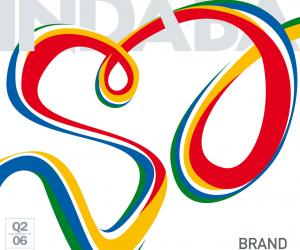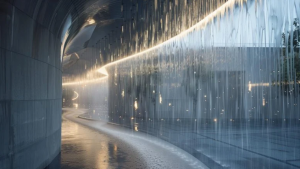First Published in
"Design should not be just about styling, but about making products and services better." This is the mantra chanted by Priestman Goode, the internationally renowned multidisciplinary studio founded by its high priest, director Paul Priestman.
It is hardly hyperbole to say that the studio sets new standards for excellence, for making products that really work - both functionally and aesthetically. Design award after design award in Europe, the Far East, and the US, and the rampant consumer uptake of Priestman Goode's iconic products provide ample proof of the agency's success in the fields of product design, transport, interiors and packaging. This work - for top brands like Virgin, Lufthansa, Boots and Marks & Spencer - is not only sold and enjoyed throughout the world, it has also been exhibited extensively and is held in museum collections.
Besides steering the London-based company, Paul himself is a Member of the Design Council and Chair of the Design Sector Skills Panel. He was President of the Design Business Association from 2001-3, and is currently a member of the D&AD Executive. He was a speaker at the 9th international Design Indaba Conference. Here we get him to part with a few more words:
It's been said that you don't drive and that you take trains everywhere? Is this true? If you had been asked to design a successful car, rather than one of the world's best trains, would that get you behind the wheel?
I do actually have a car but it's a new acquisition. I have a Nissan Cube car from Japan, one of two in the UK. It's one of the first cars to recognise the fact that roads are congested and is designed for its environment. Not simply in size, but it also has a great turning circle, which makes it easy to park in tight spots. For me this is a step change, creating a totally modern car built for urban living. I don't drive it every day - it's still the scooter to the studio for me.
Does this mean that you only fly Virgin or Lufthansa? Seriously though, do you use the products your company has designed in your own home? And if so, which ones?
I think it's important to fly competitive products so that you know what other developments are out there and what other brands are offering in terms of service. I do have some products at home such as the Boa range, the Xfm radio and the VKB.
How many studio members worked on the interior of the Virgin Airbus? And did you steer the team? How did this process work? And how long did it take?
We completed the work on the A380 from design to build in just four months. It was an incredibly tight turnaround. We had a design team of about six people on it and worked with model-makers in Kent who created a replica framework of the aircraft in their workshop. All the pieces, such as the cabin lining etc, were fitted to this model to check that everything worked before being transported and fitted into the real aircraft in Toulouse. The team involved in implementation probably numbered about 200.
What challenges were faced on this particular project?
Without question, the major challenge was producing the best quality in terms of design, finish and manufacture within such a short period of time. The mock-up became known as the "Wow" mock-up because this is the first thing everyone said when they stepped on-board. This made us realise we had pulled it off!
And going back to that train, what design "problems" did you want to solve with your execution?
Virgin Trains want to make the train a viable alternative to the increasing competition from airlines. Therefore they injected their service experience from Virgin Atlantic into the trains, making them more fun and accessible with shops on board, and radio and mobile phone/laptop chargers at all the seats. Our design facilitated all these benefits. The entire fleet is accessible in terms of disability legislation and as the train was one of the first to be made since these laws were implemented, it became an industry benchmark.
Your company is one of Britain's most successful, and you handle anything from multi-million dollar contracts for aircrafts, to gadgets for opening ring pulls. Is this a "No job is too big or too small" philosophy? What makes you take on a project?
We do work on big contracts for global companies as well as smaller ones. What interests me in a project is the design challenge and this might be to create a lie-flat aircraft seat or to create a knife block with a unique selling point. The scale of the project is irrelevant. It's the problem that you're addressing which is the attraction.
Your company Priestman Goode is based in London, which remains a world centre for design, with historical roots in the Industrial Revolution. Why, do you think, does the city still have such influence today? Does being in London "feed" you in any way?
London is an international, multi-cultural hub and naturally attracts creative minds from all over the world. There's always something new to do, see and eat, and that creates a fantastic energy, which I love. It also has some great educational institutions, which contribute to the ever-evolving design community. Because Londoners have very diverse interests, I think it results in design that is appealing to an export market. Because we're not producing something that is definably British, the work generated here naturally has a more international feel to it.
You lobby for design's functionality over form, or styling. So does Velcro turn you on? Or a paper clip, for that matter? Besides the obvious reasons, what's so bad about a little "empty" styling? Surely vacuous frippery has its place? The fashion industry thrives on it, after all… What are your thoughts on design that isn't necessarily effective? Surely it has a certain - even if functionally limited - effect?
I don't lobby for form over function; I'm looking for a balance of the two. Character is immensely important but this can be conveyed simply through form without any resort to decorative detail or superfluous styling. We buy products because we need them to serve a purpose, we don't buy them simply because they are pretty. If you buy a chair because it looks great but then it doesn't stand up, then it's pointless. I want the products I design and buy to be desirable and something I love, but I want them to work, too. I think that's a pretty reasonable request on the part of the consumer.
In South Africa, there are whole radio shows devoted to supposedly practical designs that don't work. They are the favourite on-air haunt of righteous consumers who justifiably bemoan pot handles that heat up. You yourself have designed a knife block that can be taken apart and cleaned. Any other bugbears? Surely modern technology - like touch screen programming - is doing away with some of the "old" design glitches like cooking oil stuck in the stove dials?
From my last answer, it will come as no surprise that I hate things that look good but don't work and this can as easily translate to an environment as a product. For example: a chic boutique hotel where you have to get out of bed to switch off the light. I also get frustrated by too much packaging on stuff. It's just not necessary. Finally, I hate to see investment products such as white goods, not have the durability, that they should have for their life span.
What would your dream fix-it project be?
Cruise ships and space ships are next on my list...













